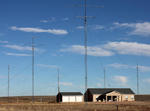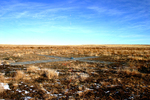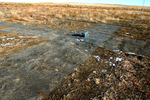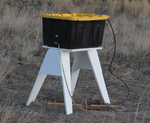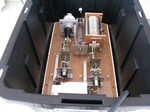Rob Sherwood (NC0B) Test Drives the FLEX 6500/6700
in the 2014 CQWW DX 160m Contest
Evaluating a 6500/6700.
At this point, since there is no agreed to standard for direct sampling radios, I will write up my experience contesting with the radio. The 6700 performed very well during the CQWW 160-meter CW contest in January. I was on FW 1.024, so there were QSK issues, but those appear to have been corrected with FW 1.1. I will wait for 1.2 before I update the radio any further.
The issue with any direct sampling radio is there are spurs of multiple kinds at low levels that are typically below band noise, and thus of no practical significance. The other factor that is in the favor of a 6000-series radio is as interfering signals get stronger and stronger, the intermodulation does not go up in a 3:1 ratio like a legacy radio. It more or less goes up at a 1:1 ratio.
Additionally legacy radios are in effect designed for 10 meters (or 6 meters), and are far too sensitive on 20 meters and below. Thus attenuation (6, 10, 12 dB etc.) is appropriate much of the time, if in a potential overload situation. On the other hand, the 6500/6700 would rarely, if ever, need attenuation, but might need the 20 dB preamp in a quiet location on 15 meters and above. The 10-dB preamp only improves the noise figure about 3 dB, so it has little practical use.
In the discussion of receiver spurious buried in band noise, the question is “what band noise standard” is appropriate, whatever band we are discussing. I found during the afore mentioned 160 meter contest, my noise floor in the morning, when I was working JAs from Colorado, was quite low compared to the ITU graph in the ARRL Handbook. At a quiet location, which includes mine in the country, 20-meter band noise is in the vicinity of -109 dBm. That level may well be in the direction of best skip, but noise skipping in other directions may be much less. While it is common to get band noise skipping in from EU or the Caribbean at that -109 dBm level, there can be excellent skip toward Alaska / JA from CO where band noise is far quieter than that. Nighttime noise on 160 meters, according to the ITU chart, is nominally -87 dBm. In my case during the CQ contest, the noise at my QTH was a bit quieter at -91 dBm. More significant, however, was how quiet it was in the morning when JAs were still skipping in. At 8 AM MST my band noise was only -105 dBm, and at 4 PM MST it was only -101 dBm. The -105 dBm band noise level is almost as quiet as the nominal 20-meter ITU value!
The point of all this is it makes it hard to nail down when low level intermod or spurs will actually be covered up by band noise. Typical band noise differs from 10 to 160 meters by over 30 dB. So a chosen band-noise value is certainly band dependent, but also in actual usage (at least in a rural environment), the band noise in the ITU chart is only an approximation that can be off at least 15 dB!
It will be interesting to see what the ARRL decides to do in respect to this testing problem. Hams with legacy radios are often fixated on buying a radio with the lowest noise floor, when in reality band noise is usually drastically higher than the receiver noise, at least on 20 meters and below. (You want the radio to be between 8 and 10 dB quieter than band noise.) Additionally it is easy to be obsessed with wanting a 100 dB radio when most of the time an 85 dB radio will perform just fine. (We are talking 85 dB worst-case numbers, not wide spaced or when measured with a 1-Hz filter like QST likes to do.)
From an operating standpoint:
The Flex control did the tuning of the 6700 all the time, as I never tuned with the mouse. Having SmartCAT on the N1MM computer worked fine (for band and frequency data), and SmartSDR ran on the 2nd computer. I pretty much left the bandwidth on the Flex set to 150 Hz, since I only do S&P. Rarely had to do anything with the mouse except slide the 20 kHz of band visible on bandscope around as I progressed up and down the band. There was some intermittent line noise during daylight hours, so the mouse was used to enable the noise blanker.
On one of the evenings there were signals from 1800 to 1900. The audio was very clean and low fatigue. The approximate 15-Hz resolution of the bandscope, when the bandscope was set to 20 kHz, was very helpful. If the signal was 10 dB above the band noise in that 15 Hz bandwidth, I could hear and work the station. If the signal was only 5 dB above the band noise, I could not copy. No need for a waterfall, not that I am used to a waterfall anyway.
QSK was terrible with FW 1.024, but that seems fixed with FW 1.1. FW 1.11 bricked some radios and FW 1.12 had all sorts of bugs according to the reflector. So I am still on 1.1 for now until 1.2 ships, nominally at the end of the April.
Overall I prefer the Kenwood TS-990S since I am 67 years old and used to knobs for the past 53 years as a ham. I only need one computer for N1MM logging for contest operation with a legacy radio. I don’t like all of the drop down menus of the Flex, but it is better with FW 1.1 than with FW 1.0, which was barely functional. One ham has written a program to run SmartSDR with an improved interface on his iPad running iOS 7. Of course it is the second computer in that case.
Having to use two computers may be a bit much for some, and if I was running CQWW SSB with the Flex, I would have to have a third PC to control all the Green Heron rotor controllers from operating position #2. I can reach the rotor controllers manually from operating position #1, but not #2 or #3. One cannot ever lose focus on the N1MM computer or you logging will get messed up, or you can end up on some other frequency or band by mistake.
Enough chatter for now.
73, Rob, NC0B
GALLERY:
FLEX-6700 TRANSMITTER SPECTRA (95W)
DOWNLOAD:
FLEX-6700 Transmit Spectra at 95 watts, all bands - Rev-B.pdf
Flex 6700 transmit spectra 95 watts all [...]
PDF-Dokument [541.6 KB]


